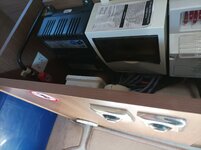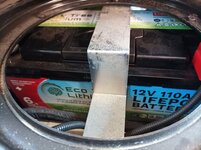I am one of the winners of the half price ecotree lithium battery draw earlier this year.
My MH came almost 8 years ago new with a 90ah lead acid leisure battery that started to give up the ghost at the end of last year so the lithium battery was very timely. But what to go for more solar? B2B? Shunt battery monitor? Thicker wiring? etc.
As we never went flat with the 90 ah lead acid ( and no solar for the first 5 years) it all sounded a bit ott so I've gone for the least cost simplest route and might modify later if needed.
We have a single 100 w solar panel and luckily I fitted a victron Bluetooth mppt regulator originally, a CB 516 charger and thats about it no b2b no inverter .
I was going to fit the battery myself but the MH was going for an MOT/ service and a quote of£15 to get the seat out and fit Vs a potential back problem decided matters. When I got the van back I set the solar to lithium and left it to charge for a couple of days and today set the charger to gel ( no lithium setting) and plugged in the ehu.
My plan is to monitor the charge state by the leisure battery voltage showing on the victron solar regulator and looking at the solar indicator with a change from bulk to float charging presumably indicating a charged or almost charged battery. After two days on solar alone and half an hour on the mains charger the solar now indicates float and the voltage a charged or almost charged leisure battery.
We're off to France soon off grid for a couple of weeks so I'll update on how things go. I know there will be a lot on here soon predicting dire consequences of this basic approach but it will show if the plug in replacement claims are valid and do remember a lot of electrical kit fitters have a strong financial impetus to recommend a quite expensive complete package.
I might look at a way of charging the vehicle battery from solar the mppt has just one output maybe a battery master or the bit of kit reviewed here the other week designed for lithium.
Here's the stuff I have at the moment
My MH came almost 8 years ago new with a 90ah lead acid leisure battery that started to give up the ghost at the end of last year so the lithium battery was very timely. But what to go for more solar? B2B? Shunt battery monitor? Thicker wiring? etc.
As we never went flat with the 90 ah lead acid ( and no solar for the first 5 years) it all sounded a bit ott so I've gone for the least cost simplest route and might modify later if needed.
We have a single 100 w solar panel and luckily I fitted a victron Bluetooth mppt regulator originally, a CB 516 charger and thats about it no b2b no inverter .
I was going to fit the battery myself but the MH was going for an MOT/ service and a quote of£15 to get the seat out and fit Vs a potential back problem decided matters. When I got the van back I set the solar to lithium and left it to charge for a couple of days and today set the charger to gel ( no lithium setting) and plugged in the ehu.
My plan is to monitor the charge state by the leisure battery voltage showing on the victron solar regulator and looking at the solar indicator with a change from bulk to float charging presumably indicating a charged or almost charged battery. After two days on solar alone and half an hour on the mains charger the solar now indicates float and the voltage a charged or almost charged leisure battery.
We're off to France soon off grid for a couple of weeks so I'll update on how things go. I know there will be a lot on here soon predicting dire consequences of this basic approach but it will show if the plug in replacement claims are valid and do remember a lot of electrical kit fitters have a strong financial impetus to recommend a quite expensive complete package.
I might look at a way of charging the vehicle battery from solar the mppt has just one output maybe a battery master or the bit of kit reviewed here the other week designed for lithium.
Here's the stuff I have at the moment




